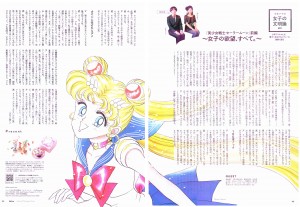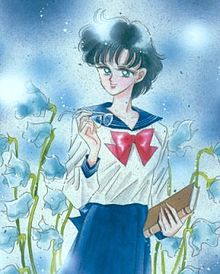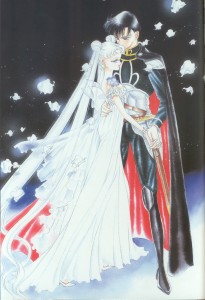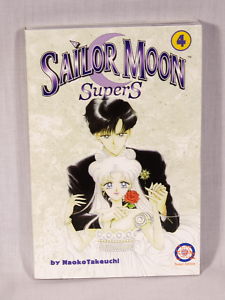Credit: Miss Dream
It’s been 11 years since Naoko Takeuchi, creator of Sailor Moon, sat down for an interview so I was super excited to read Miss Dream’s translation. One of the things I think about as I reflect on Sailor Moon is how Naoko developed her story and characters. In other words, how intentional were her choices? How did certain decisions come about? Thankfully, we do get a new glimpse of what it was like sitting in the Kodansha’s offices 20 years ago.
The first piece of information that sticks out to me is Osabu’s assertion that the scene where Sailor Moon accidentally becomes drunk in Act 4 would not pass the “censors” today. I hate the word “censor,” but I do think it’s a scene that’s pretty problematic. It’s a scene where our heroine is incapacitated and her love interest is about to kiss her. While Luna does interrupt Tuxedo Mask, declaring that he should stay away from Sailor Moon, it’s also a deeply romantic scene as the two star crossed lovers begin to recall their past lives. We, as readers, see this kiss not as a breach of consent, but an event that’s desirable. At the time, Takeuchi was a recent college graduate–I wonder how her experiences with alcohol influenced this scene.
And speaking of Tuxedo Mask, Naoko claims that he was there for “parody”–that for middle schoolers to be prowling the streets among men in black clothing, Tuxedo Mask had “a certain naughty appeal”! I’m not sure if I get the reference here. Perhaps Naoko is alluding to host clubs?
One of the most fascinating things I’ve learned from this interview is that the editors were actually against a team of beautiful girls. At it wasn’t because they wanted girls to have better role models, nope! It was because it just hadn’t been done before. The editors felt Naoko needed a comically fat character and a nerdy one with glasses if she really wanted to emulate previous fighting teams such as Gatchaman. Here I thought a team of beautiful girls was bending to the patriarchy! HA! It just goes to show you that if the idea is coming from a woman, that idea scrutinized perhaps more so than it comes from a man. And although a beautifully fat sailor guardian would have been lovely, it would have been certainly a loss if she were only there for a laugh. I wonder too if that is why is why Sailor Jupiter is so tall–she’s beautiful of course, but she has an atypical body type. Naoko also delivered a nerdy character with glasses–Sailor Mercury–but dang, she’s beautiful in those glasses!
Naoko notes that it was a challenge to convince her editors of the color scheme–she originally wanted a pastel palette, but she was told only bold, bright colors would sell magazines. I’m glad she ultimately went with bold blues and reds for Sailor Moon’s fuku–it puts Sailor Moon on par with heroes such as Superman, Wonder Woman and Spiderman. However, it does seem to explain the bright fuku of the inner guardians as compared to the darker palette of the outer guardians.
Naoko also struggled with her editors regarding Sailor Moon’s hair color–originally she wanted blonde hair for Usagi, but silver hair for Sailor Moon. This isn’t new information–she recalls this in the notes of the first artbook–however, in this interview, the incident becomes much more sinister, with an editor laughing about Sailor Moon’s “grandma” hair. Well, grandpa editor, I’d just like to inform you that this image is my ALL TIME favorite:
And, I absolutely love the hell out of this cover (although the quality of image used doesn’t do it justice):
I do find it interesting that Naoko settles on blonde hair for Usagi because she thought it was “princess-like.” Of course, the whole concept of a princess is a Western concept, but I always find it interesting that blonde hair in particular is consider *the* hair color of princesses. Either way, it sure does explain why all the princesses in Act 10 of PGSM have blonde hair!
Anyway, that’s all for this interview–what do you think? Did anything surprise you? Stay tuned for part 2 in next month’s issue!




Hmm, I wasn’t aware that blonde hair was considered “the hair color” for princesses either. Is that even true? I don’t know if it truly is, because it seems like (in Western culture that is) in order to be a princess you just have to be a young “attractive” white female anyway. At least that’s what we get all the time!
You know, it’s funny. I just finished reading the book Cinderella Ate My Daughter, and the author relates a story of how her daughter was confused by the Disney movie The Princess and the Frog. She kept talking about how she liked it when the girl helped the princess. Finally the author realized she was talking about Lotte, not Tiana. Lotte is blonde, among other things.
I’m pretty sure the hair color is a reference to the Moon People from traditional Japanese folklore, perhaps the “Tale of the Bamboo Cutter”? I know Sailor Moon draws some inspiration from that story, as I believe you’ve mentioned.
And Usagi with white/silver hair is gorgeous, that dude didn’t know what he was talking about. Think about how popular those hair colors are for anime characters now. I wonder if Sailor Moon played a role in that.
Oh! I didn’t know that the Moon People in that story had a specific hair color mentioned. I always assumed it would be black since whenever I see Kaguya or mythical beings rendered they have black hair.
You know, I checked on Wikipedia real quick after I wrote that, and there was no mention of hair color, with all the art depicting black hair like you said, but I swear I’ve read that somewhere, perhaps in a different folklore tale. Or maybe it was an article on anime and race depiction, explaining both Usagi and Goku’s Super Saiyan form from DBZ having blond hair, since some people seem to think that proves they’re “white” instead of Asian, or that Asians envy white people for some inexplicable reason. I guess I’ll have to do some digging.
One of my friends mentioned something about in Japanese culture, yellow is used to represent the moon whereas in western cultures it’s usually white (or was it the other way around?). So perhaps there’s something there!
For me, I’ve been thinking that Naoko was obsessed with white because it’s the same color as the Silver Crystal–like white represents the ultimate power and scientifically, it’s all the colors of the rainbow.